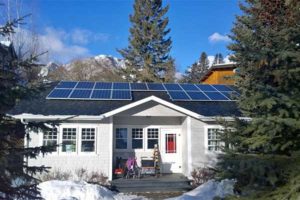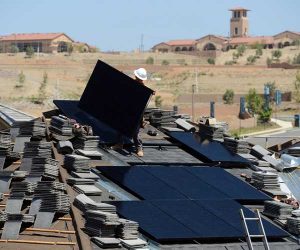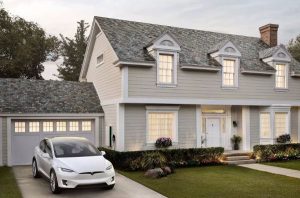A Smart Home Solar System combines home solar with battery storage and an electric vehicle (EV) charging for a whole home energy solution.
The Smart Home Solar Systems are completely customizable to a homeowner’s needs. Adaptive learning technology now makes it possible for a homeowner to prioritize power to the areas where they need it the most. Even apps can provide real-time usage and battery data, making it easier than ever to feel secure with energy production, and consumption.
A Cost-Effective and Profitable Investment
The industry has come a long way in the last ten years, with the price of solar PV panels having decreased by approximately 80% and the cost of lithium batteries by 70%. Many homeowners are now able to pay back the initial investment in their solar system in 8-10 years. Adding solar technology to your home is one of the best ways to increase its value while simultaneously reducing your family’s carbon footprint.

A solar powered home in the town of Banff, Alberta. (Credit: Town of Banff)
Who is a Smart Solar System right for?
For anyone ready to go green and help the environment, a smart solar system delivers energy freedom to homeowners while still giving them the capacity to enjoy the luxuries that make life wonderful. Generating electricity with solar PV panels helps homeowners save up to 90% on their hydro bills or to live off-grid entirely. More than ever before, home and business owners are finding it favourable to contribute to the global energy transition underway in Canada.
Drivers of Electric Vehicles
Driving an electric vehicle is a fantastic way to reduce greenhouse gas emissions and save on fuel costs. Adding rooftop solar to your home to power your EV vehicle is more economical over the long term than purchasing power from the grid.
The number of panels needed to power your vehicle will depend on the number of kilometres you drive each year as well as the range of your car’s battery. Even if you don’t currently drive an EV vehicle, many automotive companies have made a pledge to fully transition to manufacturing electric vehicles over the next 10-20 years, which means it’s only a matter of time before the majority of cars on the road will require charging stations.
Families with Greater Energy Needs
Some whole-home solar solutions are now able to fully supply a home’s main panel and up to three additional large loads such as HVAC, pool heating and electric vehicle charging. Adaptive learning technology has made it possible for homeowners to prioritize power to the areas where they need it the most with programs able to monitor parameters and reserve power for those items. This makes whole-home solar solutions a worthwhile investment, even for families with greater energy needs.
Shining through Shortcomings
Versatility
One of the past shortcomings of home solar energy solutions was the technology being tied to a specific solar configuration, such as the type of inverter. These solar systems lacked universal compatibility, limiting homeowners’ flexibility to customize the system to their specific needs. Whereas now, many Canadian engineering firms offer versatile systems that work with any solar inverter on the market.
Security
The primary focus of older solar and storage models was performance or generating enough power. Security concerns remained a factor, with homeowners feeling like they didn’t know if they had enough power to make it through an outage.
New systems are designed with capacity and control in mind, so the homeowner isn’t in the dark even during a power outage. With the ability to see real-time usage and battery level data, homeowners should never have reason to worry about whether or not they can watch a movie while also charging their vehicle.
The energy user experience is improving, with whole-home storage solutions being able to generate more power while also offering smart circuits that give homeowners the chance to decide how to use that power. Apps now provide more than just usage data, they also offer smart suggestions about how and when to optimize power reserves.

High atop a new house in KB Home’s Terramore development in Riverside County, a SunPower worker readies another solar panel for installation (Will Lester- The Press-Enterprise/SCNG)
Forecast is Sunny
The next challenge will be for regulatory systems to catch up. The technology is here and more affordable than ever, but virtual net metering and third-party ownership would help make solar even more cost-effective and beneficial moving forward.
Peak Power, a Canadian climate technology company, recently announced that they will be partnering with Oshawa Power to develop an energy platform that can show how distributed energy resources, or DERs, can help improve the long-term dependability of a local grid. DERs are small-scale electricity resources interconnected to the grid and they are key to a clean energy future for Canada. This project will aim to demonstrate how collecting clean energy, using AI-powered cleantech can reduce carbon emissions and cut energy costs. The findings will make it easier for Canadian homeowners to sell additional power generated back to the grid.
Moving Clean Technology Forward: The Sun Shines for All
Currently, we rely on Natural Gas plants to provide electricity during peak times in Canada.
A glaring resource is being underutilized, with solar energy bountiful on hot summer days when air conditioners blast at full power. Electricity generated by solar panels during peak times would directly reduce the amount of natural gas utilized and thereby decrease greenhouse emissions. A switch to more Canadian households generating power through solar energy solutions is integral in the fight against climate change.
With the scale of systems being completely customizable, solar is an adaptable and compelling solution for households with varying energy demands. The industry has already seen significant improvements in terms of affordability of solar technology.
Integration has never been easier, with many engineering firms offering turnkey solutions that include, design, permitting and installation. It’s the type of investment that pays for itself and then puts money back in homeowner’s pockets.
Over time, solar solutions will also reduce maintenance costs on Canada’s electricity grid by bringing the power source directly to the user.

Clean slate. Tesla’s new glass-covered solar roof tiles are designed to look like a traditional roof, doing away with the need for separate solar panels. (Tesla)
A New Outlook on the Horizon
Due to economic growth and a higher demand for electric vehicles, Canada’s electricity needs are rising. Electricity consumers can now have a direct and positive influence on the system. Technological advances are giving Canadians the ability to make more sophisticated energy choices, creating the potential for consumers to also provide energy back to the grid.
The number of electric vehicles on the road is expected to grow ten-fold by the end of the decade. This shift is being propelled by Government support, with Ontario Premier Dough Ford recently announcing $132 million in provincial funding being allocated to Honda Canada to revamp their Alliston auto plant to manufacture hybrid vehicles.
Prime Minister Justin Trudeau matched Ontario’s contribution from federal funds in support of Honda’s $1.4-billion dollar upgrade.
With Canada also unveiling a multi-billion plan to reduce carbon emissions, which includes significant cuts to the oil and gas sector, it is clear that clean energy solutions will have ongoing government support. A substantial portion of the funds, $800 million are going towards “green” homes and buildings.
With the need to reduce Canada’s dependency on nonrenewable sources, and meet increasing electricity demand — and as more companies now offer bundled energy solutions — it’s never been an easier and more affordable time for homeowners to consider a whole-home energy solution.



















Comments